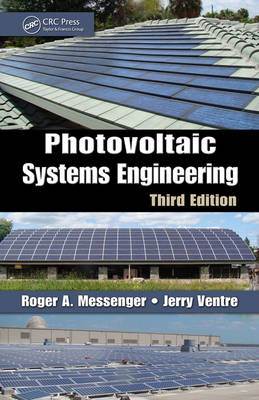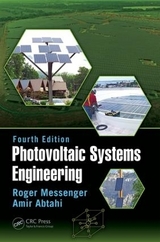
Photovoltaic Systems Engineering, Third Edition
Crc Press Inc (Verlag)
978-1-4398-0292-2 (ISBN)
- Titel erscheint in neuer Auflage
- Artikel merken
The U.S. Department of Energy now estimates a factor of 14 increase in grid-connected systems between 2009 and 2017, depending upon various factors such as incentives for renewables and availability and price of conventional fuels.
With this fact in mind, Photovoltaic Systems Engineering, Third Edition presents a comprehensive engineering basis for photovoltaic (PV) system design, so engineers can understand the what, why, and how associated with the electrical, mechanical, economic, and aesthetic aspects of PV system design. Building on the popularity of the first two editions, esteemed authors Roger Messenger and Jerry Ventre explore the significant growth and new ideas in the PV industry. They integrate their experience in system design and installation gained since publication of the last edition.
Intellectual tools to help engineers and students to understand new technologies and ideas in this rapidly evolving field
The book educates about the design of PV systems so that when engineering judgment is needed, the engineer can make intelligent decisions based on a clear understanding of the parameters involved. This goal differentiates this textbook from the many design and installation manuals that train the reader how to make design decisions, but not why. The authors explain why a PV design is executed a certain way, and how the design process is actually implemented.
In exploring these ideas, this cutting-edge book presents:
An updated background of energy production and consumption
Mathematical background for understanding energy supply and demand
A summary of the solar spectrum, how to locate the sun, and how to optimize the capture of its energy
Analysis of the components used in PV systems
Also useful for students, the text is full of additional practical considerations added to the theoretical background associated with mechanical and structural design. A modified top-down approach organizes the material to quickly cover the building blocks of the PV system. The focus is on adjusting the parameters of PV systems to optimize performance. The last two chapters present the physical basis of PV cell operation and optimization.
Presenting new problems based upon contemporary technology, this book covers a wide range of topics—including chemistry, circuit analysis, electronics, solid state device theory, and economics—this book will become a relied upon addition to any engineer’s library.
Roger Messenger is professor emeritus of electrical engineering at Florida Atlantic University in Boca Raton, FL. He received his Ph.D. in electrical engineering from the University of Minnesota and is a Registered Professional Engineer, a Certified Electrical Contractor, and a NABCEP Certified PV Installer, who enjoys working on a field installation as much as he enjoys teaching a class or working on the design of a system or contemplating the theory of operation of a system. His research work has ranged from electrical noise in gas discharge tubes to deep impurities in silicon to energy conservation. He worked on the development and promulgation of the original Code for Energy Efficiency in Building Construction in Florida and has conducted extensive field studies of energy consumption and conservation in buildings and swimming pools. Since his retirement from Florida Atlantic University in 2005, he has worked as vice president for engineering at VB Engineering, Inc., in Boca Raton. The VB Engineering team has completed several hundred PV designs to date, including the design of the 5808-module, 4-acre, 1 MW system on the roof of the Orange County Convention Center in Orlando, Florida. He has also been active in the Florida Solar Energy Industries Association and the Florida Alliance for Renewable Energy, has served as a peer reviewer for the U.S. Department of Energy, and has sat on the Florida Solar Energy Center Policy Advisory Board. He has conducted numerous seminars on designing, installing, and inspecting PV systems. Jerry Ventre is a consultant in photovoltaic systems engineering, specializing in system design, product certification, and workforce development. For 25 years, he led the photovoltaic and distributed power programs at the Florida Solar Energy Center, a research institute of the University of Central Florida. During that time, he also managed the Photovoltaic Southeast Regional Experimentation Station for the U.S. Department of Energy. He received his B.S., M.S., and Ph.D. degrees in aerospace engineering from the University of Cincinnati, and has more than 35 years of experience in research, development, design, and systems analysis. He served on the aerospace engineering faculties of both the University of Cincinnati and the University of Central Florida, is a Registered Professional Engineer, and, among many courses, taught photovoltaic systems at the graduate level. He has designed solid rocket motors and jet engines for the Advanced Engine Technology Department of the General Electric Company, and has performed research for numerous agencies, including NASA, the National Renewable Energy Laboratory, Sandia National Laboratories, Oak Ridge National Laboratory, U.S. Navy, the FAA, and the U.S. Department of Energy. He has over 150 technical publications, has been active in technical societies, and has been the recipient of a number of awards for contributions to engineering and engineering education.
Background
Population and Energy Demand
Energy Units
Current World Energy Use Patterns
Exponential Growth
Hubbert’s Gaussian Model
Net Energy, Btu Economics, and the Test for Sustainability
Direct Conversion of Sunlight to Electricity with Photovoltaics
The Sun
The Solar Spectrum
The Effect of Atmosphere on Sunlight
Sunlight Specifics
Capturing Sunlight
Introduction to PV Systems
The PV Cell
The PV Module
The PV Array
Energy Storage
PV System Loads
PV System Availability
Associated System Electronic Components
Generators
Balance of System (BOS) Components
Grid-Connected Utility-Interactive PV Systems
Applicable Codes and Standards
Design Considerations for Straight Grid-Connected PV Systems
Design of a System Based on Desired Annual System Performance
Design of a System Based on Available Roof Space
Design of a Microinverter-Based System
Design of a Nominal 21 kW System that Feeds a Three-Phase Distribution Panel
Design of a Nominal 250 kW System
System Performance Monitoring
Mechanical Considerations
Important Properties of Materials
Establishing Mechanical System Requirements
Design and Installation Guidelines
Forces Acting on PV Arrays
Array Mounting System Design
Computing Mechanical Loads and Stresses
Stand-off, Roof Mount Examples
Battery-Backup Grid-Connected PV Systems
Battery-Backup Design Basics
A Single-Inverter 120 V Battery-Backup System Based on Standby Loads
A 120/240 V Battery-Backup System Based on Available Roof Space
An 18 kW Battery-Backup System Using Inverters in Tandem
AC-Coupled Battery-Backup Systems
Battery Connections
Stand-Alone PV Systems
The Simplest Configuration: Module and Fan
A PV-Powered Water-Pumping System
A PV-Powered Parking Lot Lighting System
A Cathodic Protection System
A Portable Highway Advisory Sign
A Critical-Need Refrigeration System
A PV-Powered Mountain Cabin
A Hybrid-Powered, Off-Grid Residence
Summary of Design Procedures
Economic Considerations
Life-Cycle Costing
Borrowing Money
Payback Analysis
Externalities
Externalities and Photovoltaics
Externalities
Environmental Effects of Energy Sources
Externalities Associated with PV Systems
The Physics of Photovoltaic Cells
Optical Absorption
Extrinsic Semiconductors and the pn Junction
Maximizing PV Cell Performance
Exotic Junctions
Present and Proposed PV Cells and Systems
Silicon PV Cells
Gallium Arsenide Cells
Copper Indium (Gallium) Diselenide Cells
Cadmium Telluride Cells
Emerging Technologies
New Developments in System Design
Appendices
Index
| Erscheint lt. Verlag | 3.3.2010 |
|---|---|
| Zusatzinfo | 263, 325, 384, 385, 387, 390, 392, 395,401& 414; New pgs 53,136,143,144,149,153,231,260, 261; 82 Tables, black and white; 182 Illustrations, black and white |
| Verlagsort | Bosa Roca |
| Sprache | englisch |
| Maße | 156 x 235 mm |
| Gewicht | 862 g |
| Themenwelt | Technik ► Elektrotechnik / Energietechnik |
| ISBN-10 | 1-4398-0292-0 / 1439802920 |
| ISBN-13 | 978-1-4398-0292-2 / 9781439802922 |
| Zustand | Neuware |
| Haben Sie eine Frage zum Produkt? |
aus dem Bereich



